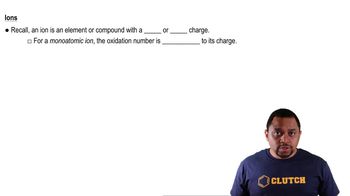Textbook Question
Based on the molecular views, classify each substance as an atomic element, a molecular element, an ionic compound, or a molecular compound.
654
views
 Verified step by step guidance
Verified step by step guidance



Based on the molecular views, classify each substance as an atomic element, a molecular element, an ionic compound, or a molecular compound.
Write a formula for the ionic compound that forms between each pair of elements. a. silver and chlorine b. sodium and sulfur c. aluminum and sulfur d. potassium and chlorine
Write a formula for the compound that forms between potassium and each polyatomic ion. a. acetate b. phosphate c. sulfate d. nitrate
Name each ionic compound. a. SnCl4 b. PbI2 c. Fe2O3 d. CuI2 e. HgBr2 f. CrCl2
Name each ionic compound containing a polyatomic ion. a. CuNO2 b. Mg(C2H3O2)2 c. Ba(NO3)2 d. Pb(C2H3O2)2
Name each ionic compound containing a polyatomic ion. a. Ba(OH)2 b. NH4I c. NaBrO4 d. Fe(OH)3